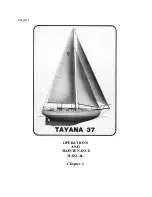
Chapter 2: Components/Systems 7
4100 SCB Owner’s Manual Supplement
Davit (Option)
Your yacht may be equipped with an optional electric davit. Be sure to read the
davit manufacturer’s manual for detailed operating instructions and safety haz-
ards. Observe the following:
•
The davit controls are typically located on the back side of the davit, just
above the davit base.
•
Inspect the davit’s cable often for wear and replace if frayed. The cable
should be kept tight and even on the spool when under tension during winch
operation.
•
After lifting a load onto the yacht, remove the davit cables and secure the
load to the deck.
•
Always secure the davit to the davit eye when the davit is not in use.
E l e c t r i c a l S y s t e m
We strongly recommend you read and understand this chapter and the electrical section of the owner’s manual.
Detailed electrical routing drawings are provided in Chapter 3 of this supplement; wiring schematics in Chapter 4.
DAVIT
DAVIT EYE
TRANS
OM PL
ATFO
RM
DAVIT LOCATION
PRODUCT & PERSONAL INJURY HAZARDS!
•
DO NOT allow passengers inside a suspended boat. Falling from a suspended
boat may cause injury or even death.
•
Only operate the davit when it is securely locked in the upright position.
•
DO NOT exceed the davit’s maximum load limit.
•
Since water is heavy, lifting the dinghy to drain its bilge may exceed the davit’s load limit.
•
Use extreme care when using the davit in rough weather or rough sea conditions as the
load may start swinging.
WARN I NG!
!
EXTREME FIRE, SHOCK & EXPLOSION HAZARDS!
•
To minimize the risks of fire and explosion, NEVER install knife switches or other arcing
devices in the fuel compartments.
•
NEVER substitute automotive parts for marine parts. Electrical, ignition and fuel system
parts were designed and manufactured to comply with rules and regulations that minimize
risks of fire and explosion.
•
Only qualified personnel should install batteries and/or perform electrical system
maintenance.
•
Insure that all battery switches are in the OFF position before performing any work in the
engine spaces.
•
DO NOT modify the electrical systems or relevant drawings.
DANGER!
!
FIRE, OPEN FLAME & EXPLOSION HAZARDS!
•
Fuel fumes are heavier than air and will collect in the bilge areas where they can be acci-
dently ignited. Visually and by smell (sniff test), check the engine and fuel compartments
for fumes or accumulation of fuel. ALWAYS operate the bilge blowers for at least four
minutes prior to engine starting, electrical system maintenance or activation of electrical
devices.
•
Minimize the danger of fire and explosion by not exposing batteries to open flame or
sparks. It is also important that no one smoke anywhere near the batteries.
WARN I NG!
!
Summary of Contents for 4100 SCB
Page 1: ......
Page 6: ......
Page 41: ...Chapter 4 Wiring Schematics 35 4100 SCB Owner s Manual Supplement Diesel Engine Harness...
Page 42: ...36 Chapter 4 Wiring Schematics 4100 SCB Owner s Manual Supplement Gas Engine Harness...
Page 43: ...Chapter 4 Wiring Schematics 37 4100 SCB Owner s Manual Supplement Hull Harness...
Page 44: ...38 Chapter 4 Wiring Schematics 4100 SCB Owner s Manual Supplement Lower Helm Harness Option...
Page 45: ...Chapter 4 Wiring Schematics 39 4100 SCB Owner s Manual Supplement Deck Harness...
Page 46: ...40 Chapter 4 Wiring Schematics 4100 SCB Owner s Manual Supplement 120V AC DC Panel...
Page 47: ...Chapter 4 Wiring Schematics 41 4100 SCB Owner s Manual Supplement 240V AC DC Panel Option...
Page 51: ...Chapter 4 Wiring Schematics 45 4100 SCB Owner s Manual Supplement V berth Deck Harness...
Page 53: ...Owner s Notes...
Page 54: ...Owner s Notes...
Page 55: ......
Page 56: ...Part Number 1706510 Rev A Maxum Marine P O Box 6050 Arlington WA 98223 6050 360 435 6534...














































